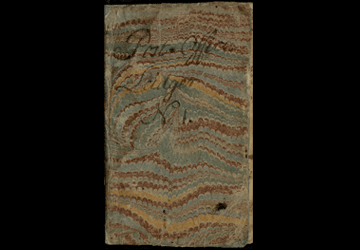
Post Office Leidger No. 1: 1737-1742
This volume of less than 100 pages is an index of names under their initial letter and dated entries following each name showing charges and payments received. The unpaid accounts were “Carry’d to New Ledger.”—Ledger No. 2.

List of Letters in the Post Office: circa 1741
“List of Lettars in the Post Office,” lists unclaimed letters which were, most probably, the dead letters found in any post office. This volume is ca. 50 pages.

Post Office Accounts: 1741
This large, foliated sheet of paper is the earliest known example of Benjamin Franklin's three-column system of accounting for letters received into the post office, arranged by date and city of origination. Franklin refined this system in the “Post Office Book: 1748-1752” and made it official postal protocol in 1753.

Post Office Ledger No. 2: 1742-1748
The balances due Franklin from unpaid postage in “Leidger No. 1” are entered here and many people owed Franklin money. Some of the accounts are marked “Paid” and some have a line drawn through them, possibly indicating “Paid."” Such outstanding entries due Franklin were entered in “Ledger E.” This Post Office Ledger, No. 2, is a large ledger of ca. 325 pages.

Post Office Accounts: 1743
“Post Office Accounts drawn out Nov. 1743” [Philadelphia Post Office Record Book No. 3] is a small volume of ca. 50 pages. It contains a list of names with amounts due with notes as to letters delivered, paid, etc. The names are abstracted from Post Office Ledger, No. 2.

Post-Office Accounts: 1744
A small volume of 32 pages dated 1744 April 18. Names are alphabetically arranged with corresponding figures indicating the weigths in pennyweight and grains. Some amounts, but not all, match entries in Ledger No. 2.

Post Office Accounts: 1748
“Post Office Accounts” May 18, 1748, is the continuation of the above ledger [Philadelphia Post Office Record Book No. 3, B F85f6.11c]. It contains 68 unnumbered pages. Per the Franklin Papers (vol. II, p. 180-181), “the amounts owed by each [name-entry] correspond[s] to the subtotals entered in May 1748 in the ledger described above as No. 2 [B F85f6.11b, Philadelphia Post Office Ledger, No.2].”

Post Office Accounts: 1748-1749
This large sheet lists names and amounts due by date, similar to the entries in the earlier post office ledgers. The folds in the paper indicate that it may have originally been intended to imitate the narrow octavo form of 1741's List of Letters in the Post Office.

Post Office Book: 1748-1752
This volume of 372 pages records receipt and dispatch of all mail in the Philadelphia Post Office between May 25, 1748 and July 23, 1752. Deliveries into the Post Office from out of town were listed, letter by letter, by the names of the addressees, weight and amount due, paid or free. Outgoing mail was simply listed by number of sheets and weight, not by individual letters.

Post Office Book: 1757-1764
Franklin, in 1757, appointed his wife’s nephew-in-law, William Dunlap, to succeed William Franklin as the Philadelphia postmaster. This volume of ca. 90 written pages lists the letters received at the post office and may well supply a fair picture of the colonial postal system with Philadelphia as a focal point.

Post Office Book, Letters Sent: 1764-1767
A series of loose printed sheets, filled in manuscript, under the headings of: Date of the Bills sent; To what Office the Letters were sent; Number of unpaid Letters, Single, Double, Treble, Pacquet, Sums unpaid, Dwt., Gr.; Number of paid Letters; Free Letters, Single, Double, Treble, Pacquet.

Post Office Book, Letters Received: 1767-1768
These printed forms were filled in in manuscript and list the letters received from other colonial post offices or from ships in the Philadelphia Post Office by Postmaster Thomas Foxcroft.














